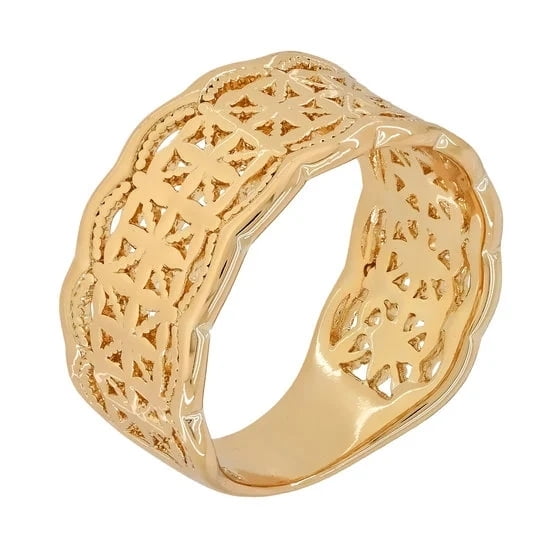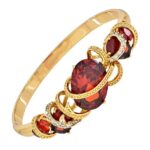Plated jewelry has become increasingly popular in recent years due to its stunning appearance, affordability, and versatility. Whether it’s gold, silver, rose gold, or another type of plating, this jewelry offers a beautiful and cost-effective alternative to solid precious metals. However, caring for plated jewelry requires some special attention to ensure its longevity and keep it looking its best.
Plated jewelry is created by applying a thin layer of precious metal onto a base metal through an electroplating process. This layer enhances the beauty of the piece and gives it that desired luxurious look. Plated jewelry allows fashion enthusiasts to stay on-trend without breaking the bank.
Affordability isn’t the only advantage of plated jewelry; its versatility is equally enticing. With various plating options available, you can find the perfect match for any outfit or occasion. From elegant gold-plated necklaces to sassy silver rings, there is something for everyone’s taste.
To keep your plated jewelry looking pristine and new for longer, you need to understand how to care for it properly. In this article, we will guide you through everything you need to know about maintaining your cherished pieces of plated jewelry.
From understanding different types of plating to dos and don’ts when wearing them, cleaning and maintenance tips to storing options, we’ve got you covered. So dive into our comprehensive guide on caring for plated jewelry and let your favorite pieces shine bright with every wear.
Understanding the Different Types of Plating
Plated jewelry comes in a variety of different types of plating, each with its own unique characteristics and care requirements. By understanding the different types of plating used in jewelry, you can better care for your pieces and ensure they last as long as possible.
Gold Plating
Gold plating is one of the most popular choices for plated jewelry due to its timeless appeal and affordability. Gold-plated jewelry is created by applying a thin layer of gold onto a base metal, typically brass or sterling silver.
While gold plating adds a touch of luxury to any piece, it is important to note that it can wear off over time. To care for gold-plated jewelry, avoid exposing it to harsh chemicals or abrasive materials and gently clean it using mild soap and water.
Silver Plating
Silver plating offers the look of sterling silver at a fraction of the cost. It involves applying a layer of silver over a base metal such as copper or nickel. Like gold plating, silver plating may also wear off with regular use and exposure to certain substances. To keep your silver-plated jewelry looking its best, it’s important to avoid contact with products containing sulfur (such as rubber bands) and remove your jewelry before swimming or showering.
Rose Gold Plating
Rose gold plating has become increasingly popular for its soft and feminine appearance. It involves applying a layer of rose gold over another metal, such as copper or brass.
While rose gold-plated jewelry requires similar care to other types of plated jewelry, it is worth noting that the warm hue may fade slightly over time. To extend the life of your rose gold-plated pieces, store them separately from other items that could scratch their surface and avoid exposing them to harsh chemicals.
By understanding the different types of platings used in jewelry, you can better care for your plated pieces and ensure they maintain their beauty for longer. Whether you choose gold, silver, or rose gold plating, following the recommended care guidelines can help preserve the shine and vibrancy of your favored accessories.
Remember to always handle your plated jewelry with care and avoid exposing it to harsh chemicals or abrasive materials. With proper maintenance, you can enjoy the beauty of your plated jewelry for years to come.
Dos and Don’ts of Wearing Plated Jewelry
Plated jewelry offers a beautiful and affordable way to accessorize any outfit. However, it is important to take certain precautions while wearing plated jewelry to ensure its longevity and prevent damage. In this section, we will discuss the dos and don’ts of wearing plated jewelry.
Firstly, one of the most important things to remember when wearing plated jewelry is to avoid exposing it to moisture. Plated jewelry should be kept dry at all times, as moisture can cause the plating to tarnish or even peel off. This means removing plated jewelry before swimming, showering, or participating in any activities that may cause excessive sweating.
Secondly, it is crucial to take off plated jewelry before engaging in activities that could potentially scratch or damage it. For example, wearing plated rings while doing household chores or sports activities may lead to scratches or even dents in the plating. It is best to remove your plated jewelry beforehand and keep them safe until you are done with these activities.
Another important point is to avoid applying lotions, perfumes, or harsh chemicals directly onto plated jewelry. Certain substances can react negatively with the plating and diminish its shine over time. To preserve the beauty of your plated jewelry, apply lotions and perfumes onto your skin first and allow them to fully absorb before putting on your jewelry.
Lastly, be mindful of how you store your plated jewelry when it’s not being worn. Keeping them loosely piled together or tangled can result in scratches and damage to the plating. Instead, store each piece separately in soft cloth pouches or dedicated compartments in a jewelry box to minimize contact with other pieces.
By following these dos and don’ts of wearing plated jewelry, you can enjoy their beauty for years to come. Taking care of your plated pieces ensures that they maintain their shine and sparkle, allowing you to always look stylish and put-together with minimal effort.
Cleaning and Maintenance Tips
Taking proper care of plated jewelry is essential to maintain its beauty and longevity. Regular cleaning and maintenance can help preserve the plating, prevent tarnishing, and prolong the lifespan of your favorite pieces. Here are some simple yet effective tips to keep your plated jewelry looking its best:
- Avoiding Abrasive Materials: When cleaning plated jewelry, it’s important to use gentle materials that won’t scratch or damage the surface. Soft cloths made from microfiber or a cotton ball are great options for removing dirt or fingerprints without harming the plating.
- Mild Cleaning Solutions: Plated jewelry should be cleaned using mild, non-abrasive cleaning solutions. You can make your own by mixing a few drops of mild dish soap with warm water. Dip a soft cloth into the solution and gently wipe down the jewelry, making sure to clean all surfaces.
- Delicate Brushing Technique: For extra stubborn dirt or debris, you may need to use a soft-bristled toothbrush. However, it’s crucial to be gentle while using this technique to avoid scratching the plating. Gently brush in small circular motions to remove any buildup in hard-to-reach areas.
- Avoid Excessive Moisture: Water can accelerate tarnishing on plated jewelry, so it’s important to minimize moisture exposure during cleaning. After cleaning your jewelry, ensure you dry it thoroughly before storing it away.
- Avoid Harsh Chemicals: It’s important to avoid exposing plated jewelry to harsh chemicals that can damage the plating. This includes household cleaners, bleach, ammonia-based products, and even some cosmetics like hairspray or perfume. Always remove your plated jewelry before engaging in activities that involve contact with these substances.
Remember that each type of plating may require specific care instructions based on its composition (gold-plated, silver-plated, etc). Be sure to refer to any care guidelines provided by the manufacturer or consult a professional jeweler for specific advice. By following these cleaning and maintenance tips, you can keep your plated jewelry looking beautiful for years to come.
Storing Plated Jewelry to Prevent Tarnishing
Proper storage is essential for preventing tarnishing and prolonging the lifespan of plated jewelry. Plated jewelry is particularly susceptible to tarnish, as the thin layer of plating can wear off over time, exposing the base metal underneath. To minimize exposure to air and moisture, it is important to store plated jewelry in a manner that provides adequate protection.
One effective way to store plated jewelry is by using a jewelry box or organizer. These boxes often come with compartments or dividers that help keep each piece separated and prevent them from scratching against one another. Additionally, some jewelry boxes are lined with anti-tarnish fabric or have built-in features designed specifically for preventing tarnish.
Another option for storing plated jewelry is using anti-tarnish pouches or bags. These pouches are typically made of special fabrics or materials that absorb moisture and slow down the oxidation process. Simply place your plated jewelry inside an anti-tarnish pouch before storing it away. These pouches are also convenient for travel, as they provide an extra layer of protection against potential damage while on-the-go.
It’s important to note that storing plated jewelry properly also includes keeping it away from harsh environments. Avoid storing your plated jewelry in areas with extreme temperatures, high humidity levels, or direct sunlight. These conditions can accelerate tarnishing and damage the plating.
| Storage Option | Advantages | Disadvantages |
|---|---|---|
| Jewelry Boxes/Organizers | – Keeps jewelry separated and prevents scratches
| – May take up space
|
| Anti-Tarnish Pouches/Bags | – Absorbs moisture and slows down oxidation
| – May require additional purchase
|
Avoiding Contact with Harsh Chemicals and Substances
Introduction
When it comes to caring for plated jewelry, one of the most important factors to consider is avoiding contact with harsh chemicals and substances. Plated jewelry is more delicate compared to solid gold or silver pieces, and exposure to chemicals can cause the plating to deteriorate over time. This section will provide valuable information on the potential damage caused by chemicals and offer practical tips on how to protect your plated jewelry while using these substances.
Educating Readers on Potential Damage
It’s essential for jewelry enthusiasts to understand that harsh chemicals and substances can have a detrimental impact on plated jewelry. Chemicals commonly found in everyday products like perfumes, lotions, cleaning agents, and even certain types of hand sanitizers contain ingredients that can react with the plating. These reactions can lead to discoloration, fading, or even peeling of the plating. Therefore, it is crucial to minimize direct contact between these chemicals and your plated pieces.
To better protect your plated jewelry from harm, it’s advisable to remove them before engaging in activities that involve chemical exposure. Whether you’re applying skincare products or cleaning the house with strong detergents, taking off your plated jewelry beforehand can significantly reduce the risk of damage.
Tips for Protecting Plated Jewelry
While complete avoidance of all chemicals may not always be possible, there are several steps you can take to safeguard your plated jewelry:
- Apply First, Then Adorn: Make sure any lotions, perfumes, or sprays are fully absorbed into your skin before wearing your plated jewelry. This way, the chemicals won’t adhere directly to the piece.
- Wait After Application: Give yourself a few minutes after applying personal care products before putting on your plated jewelry. Allowing some time for the products to settle will further minimize any potential chemical transfer.
- Remove During Cleaning: When using household cleaning agents, it’s best to remove your plated jewelry entirely. The chemicals present in these cleaning products can be particularly damaging to the plating, so it’s safer to keep your cherished pieces away from harm’s way.
By following these simple yet effective tips, you can significantly extend the lifespan and maintain the beauty of your plated jewelry, ensuring that they continue to shine for years to come. Remember, prevention is key when it comes to avoiding damage from harsh chemicals and substances.
Repairing and Replating Options
Plated jewelry, like any other type of jewelry, may experience chipped or damaged plating over time. However, there are repair options available to address these issues and extend the life of your beloved pieces. In this section, we will explore some common repairing and replating options for plated jewelry.
Repairing chipped or damaged plating can be done by a professional jeweler who specializes in jewelry repair. They have the necessary skills and tools to assess the damage and apply new plating to the affected areas. The process involves stripping off the old plating, preparing the surface for new plating, and applying a fresh layer of plating.
If you have minor scratches or small areas with chipped plating on your jewelry, you might consider using touch-up pens designed specifically for plated jewelry. These pens contain a liquid solution with metal particles that can fill in small imperfections and restore the appearance of the jewelry temporarily.
In some cases, replating may be necessary if the damage is extensive or if you want to refresh the entire piece. Replating involves removing all existing plating from the jewelry and applying a new coat of metal. It is important to note that not all jewelry can be replated, especially if it has gemstones or intricate designs that could be damaged during the process. Consulting with a jeweler before opting for replating is advisable.
| Repair Option | Description |
|---|---|
| Professional Repair | A professional jeweler assesses and repairs chipped or damaged plating. |
| Touch-up Pens | Pens filled with metal particles used to fill in minor imperfections on plated jewelry. |
| Replating | The removal of existing plating and application of a new coat of metal. |
It is important to note that while repairing and replating can restore the appearance of plated jewelry, these processes are temporary solutions. Over time, the plating may wear off again due to regular use and exposure. Therefore, it is essential to continue practicing proper care and maintenance techniques to help prolong the life of your plated jewelry.
Frequently Asked Questions
In this section, we will address some common questions that people have about caring for plated jewelry. The following are a few of the most frequently asked questions:
- Can plated jewelry be resized?
- Can I swim with plated jewelry?
- How do I clean plated jewelry with gemstones?
- How often should I clean my plated jewelry?
- How long does plating typically last before it needs to be replated?
Plated jewelry is generally not recommended for resizing. The plating is a thin layer applied to the surface of the base metal, and resizing may result in damaging or even removing this delicate layer. Therefore, it is best to purchase plated jewelry in the correct size or opt for adjustable designs when possible.
It is best to avoid wearing plated jewelry while swimming, especially in chlorinated pools or saltwater. Both chlorine and salt can accelerate the tarnishing process and potentially strip away the plating over time. Additionally, exposure to water can also cause discoloration or fading of certain types of plating.
Cleaning plated jewelry with gemstones requires extra care to prevent any damage. It is important to avoid submerging these pieces in water, as excessive moisture can affect the adhesive used to secure the gemstones. Instead, gently clean them using a soft cloth dampened with mild soap and warm water, and then pat dry thoroughly.
The frequency of cleaning your plated jewelry depends on how often you wear it and how quickly it becomes tarnished or loses its luster. As a general guideline, it is recommended to clean your plated jewelry every couple of months or as needed. Regularly inspecting your pieces for any signs of tarnish or dirt buildup will help you determine when cleaning is necessary.
The lifespan of plating varies depending on factors such as the type of plating used, how frequently the jewelry is worn, and how well it is cared for. On average, plating can last anywhere from several months to a few years. However, with proper care and maintenance, it is possible to extend the life of plating and delay the need for replating.
By addressing these frequently asked questions, we hope to provide clarity and guidance on caring for plated jewelry. Remember that proper care and maintenance play a significant role in preserving the beauty and longevity of your cherished pieces.
Conclusion
In conclusion, plated jewelry offers a beautiful and affordable option for accessorizing any outfit. By understanding the different types of plating and their pros and cons, individuals can make informed choices about the care and maintenance of their jewelry. The dos and don’ts of wearing plated jewelry provide valuable tips for avoiding damage while maximizing its lifespan.
Cleaning and maintenance are essential to keep plated jewelry looking its best. Following the step-by-step guide provided in this article, along with using specific cleaning products and techniques for different types of plating, will help individuals maintain the shine and longevity of their jewelry. Proper storage is also crucial in preventing tarnishing, so investing in jewelry boxes or anti-tarnish pouches is highly recommended.
It is important to note that avoiding contact with harsh chemicals and substances will significantly prolong the life of plated jewelry. Taking precautions such as removing jewelry before applying perfumes or lotions, or before engaging in activities involving cleaning agents, can help protect the plating from damage.
Lastly, for those experiencing chipped or damaged plating, repairs or replating options may be available to extend the life of your cherished pieces. It’s always a good idea to consult with a professional jeweler to explore these possibilities.
By following these guidelines and taking proper care of plated jewelry, individuals can ensure that they continue to embrace its beauty for years to come. Remembering the key points covered in this article will allow you to enjoy your plated jewelry collection while preserving its shine and value.
Frequently Asked Questions
How long does plated jewelry last?
The longevity of plated jewelry can vary depending on factors such as the quality of the plating, frequency of wear, and how well it is maintained. Generally, plated jewelry can last anywhere from a few months to several years.
However, the thin layer of metal used for plating will inevitably wear off over time, revealing the base metal underneath. To extend the lifespan of plated jewelry, it is recommended to handle it with care, avoid exposing it to harsh chemicals or abrasive materials, and store it properly when not in use.
Can you wear plated jewelry in the shower?
While some plated jewelry may claim to be water-resistant or waterproof, it is generally not advisable to wear plated jewelry in the shower. The repeated exposure to water, soap residue, and shampoo can accelerate the process of plating deterioration and increase the risk of tarnishing or discoloration.
Additionally, hot water or steam from showers can further exacerbate these effects. To protect your plated jewelry and ensure its longevity, it is best to remove it before entering the shower or any other activities that involve prolonged water exposure.
Does plated jewelry tarnish?
Plated jewelry has a tendency to tarnish over time due to various factors such as exposure to air, moisture, body oils, cosmetics, and pollutants. Although plating offers a layer of protection against tarnish compared to non-plated metals like copper or brass, it is important to note that this layer will eventually wear off. Once the base metal is exposed through scratches or regular wear and tear, it becomes more susceptible to tarnishing.
To minimize tarnish on your plated jewelry and maintain its shine for longer periods, storing it in a cool and dry place away from direct sunlight or moisture when not being worn can prove beneficial. Regular cleaning with gentle solutions specifically formulated for plated items can also help remove any buildup that may contribute to tarnish over time.

Welcome to my jewelry blog! My name is Sarah and I am the owner of this blog.
I love making jewelry and sharing my creations with others.
So whether you’re someone who loves wearing jewelry yourself or simply enjoys learning about it, be sure to check out my blog for insightful posts on everything related to this exciting topic!





